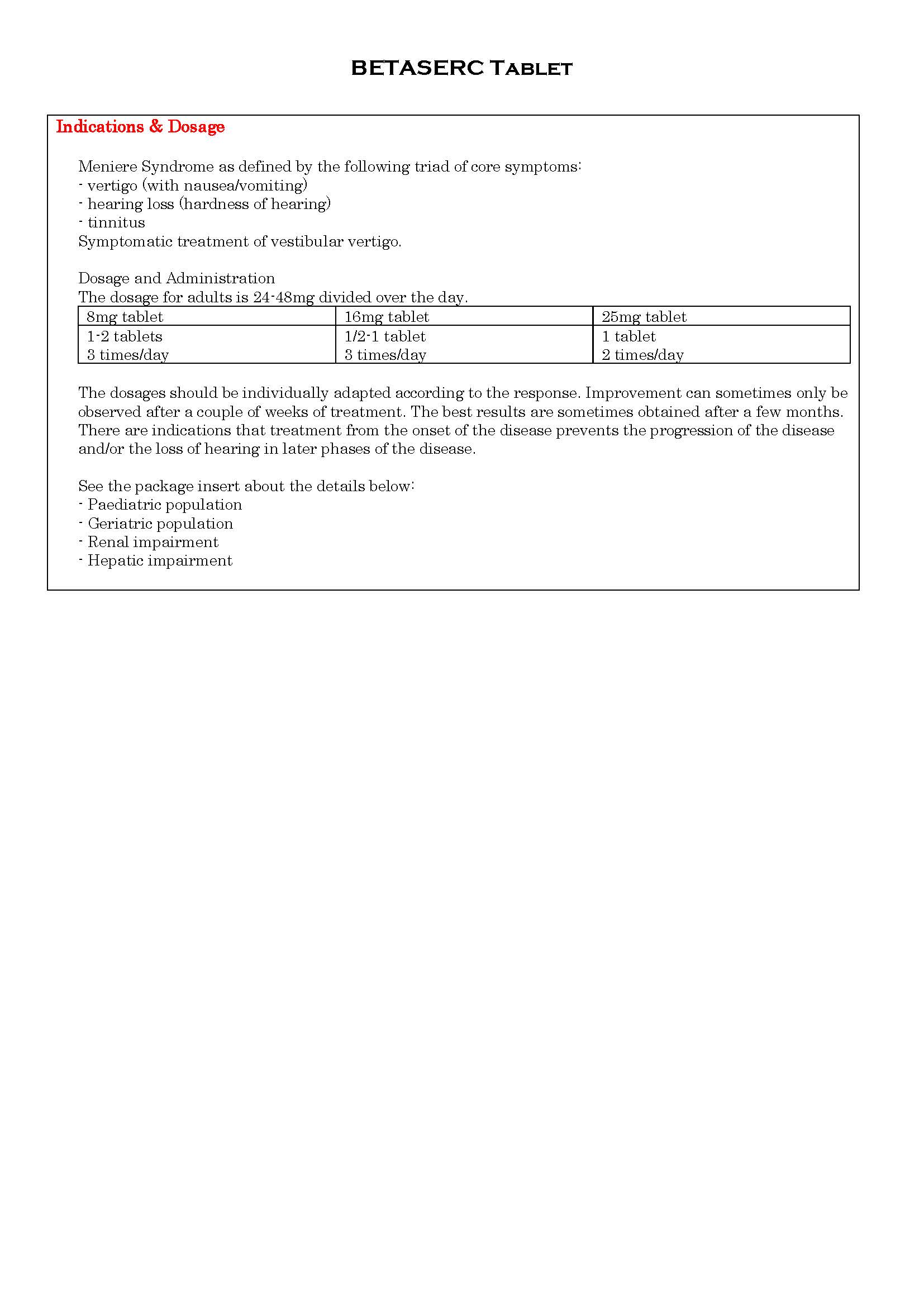BETASERC Tablet
ក្រុមហ៊ុនផលិតឱសថ:
Mylan Laboratories SAS, France
- សារធាតុសកម្ម
- ប្រសិទ្ធិភាពព្យាបាល និង កម្រិតប្រើប្រាស់
- ហាមប្រើ
- ផលរំខាន
- អន្តរប្រតិកម្ម
- ស្ត្រីមានផ្ទៃពោះ និង ស្ត្រីបំបៅដោះកូន
- ការប្រុងប្រយ័ត្នជាពិសេស
- សកម្មភាពឱសថ បរិយាយប័ណ្ណឱសថ
-
សារធាតុសកម្ម
1. BETASERC Tablet 8mg:
Betahistine dihydrochloride 8mg
2. BETASERC Tablet 16mg:
Betahistine dihydrochloride 16mg
3. BETASERC Tablet 24mg:
-
ប្រសិទ្ធិភាពព្យាបាល និង កម្រិតប្រើប្រាស់

-
ហាមប្រើ
Hypersensitivity to the active substance or to any of the excipients.
Phaeochromocytoma.
-
ផលរំខាន
Gastrointestinal disorders
Common: nausea and dyspepsia
Nervous system disorders
Common: headache
Immune system disorders
Hypersensitivity reactions, e.g. anaphylaxis
Gastrointestinal disorders
Mild gastric complaints (e.g. vomiting, gastrointestinal pain, abdominal distension and bloating). These can normally be dealt with by taking the dose during meals or by lowering the dose.
Skin and subcutaneous tissue disorders
Cutaneous and subcutaneous hypersensitivity reactions, in particular angioneurotic oedema, urticaria, rash, and pruritus.
-
អន្តរប្រតិកម្ម
No in vivo interaction studies have been performed. Based on in vitro inhibition on CYP enzyme is expected.
In vitro data indicate an inhibition of betahistine metabolism by drugs that inhibit MAO including MAO subtype B (e.g. selegiline). Caution is recommended when using betahistine and MAO inhibitors (including MAO-B selective) concomitantly.
A betahistine is an analogue of histamine, interaction of betahistine with antihistamines may in theory affect the efficacy of one of these drugs.
-
ស្ត្រីមានផ្ទៃពោះ និង ស្ត្រីបំបៅដោះកូន
See the package insert about the details below.
Pregnancy
There are no adequate data from the use of betahistine in pregnant woman.
Betahistine should not be used during pregnancy unless clearly necessary.
Lactation
It is not known whether betahistine is excreted in human milk.
The importance of the drug to the mother should be weighed against the benefits of nursing and the potential risk for the child.
-
ការប្រុងប្រយ័ត្នជាពិសេស
Patients with bronchial asthma and history of peptic ulcer need to be carefully monitored during therapy.
May cause allergic reactions (possibly delayed).
-
សកម្មភាពឱសថ
Pharmacotherapeutic group: Anti-vertigo preparations.
The mechanism of action of betahistine is only partly understood. There are several plausible hypotheses that are supported by animal studies and human data:
- Betahistine affects the histaminergic system:
Betahistine acts both as a partial histamine H1-receptor agonist and histamine H3-receptor antagonist also in neuronal tissue, and has negligible H2-receptor activity. Betahistine increases histamine turnover and release by blocking presynaptic H3-receptors and inducing H3-receptor down regulation.
- Betahistine may increase blood flow to the cochlear region as well as to the whole brain:
Pharmacological testing in animals has shown that blood circulation in the striae vascularis of the inner ear improves, probably by means of a relaxation of the precapillary sphincters of the microincurculation of the inner ear. Betahistine was also shown to increase cerebral blood flow in humans.
- Betahistine facilitates vestibular compensation:
Betahistine accelerates vestibular recovery after unilateral neurectomy in animals, by promoting and facilitating central vestibular compensation; this effect, which is characterized by an up-regulation of histamine turnover and release, is mediated through H3 receptor antagonism. In human subjects, recovery time after vestibular neurectomy was also reduced when treated with betahistine.
- Betahistine alters neuronal firing in the vestibular nuclei:
Betahistine was also found to have a dose dependent inhibiting effect on spike generation of neurons in lateral and medical vestibular nuclei.
The pharmacodynamic properties as demonstrated in animals may contribute to the therapeutic benefit of betahistine in the vestibular system.
The efficacy of betahistine was shown in studies in patients with vestibular vertigo and with Meniere’s disease as was demonstrated by improvements in severity and frequency of vertigo attacks.
*ព័ត៌មានឱសថត្រូវបានរៀបរៀងដោយ អ៊ីម៉ាតុគឹ មេឌីក (ខេមបូឌា) ដោយផ្អែកលើប្រភពព័ត៌មានខាងក្រោម។ សម្រាប់ព័ត៌មានលម្អិត សូមស្វែងរកនៅក្នុងក្រដាសព័ត៌មាននៃឱសថនីមួយៗ ឬ សាកសួរទៅកាន់ក្រុមហ៊ុនឱសថឬតំណាងចែកចាយនៃឱសថនីមួយៗ។
ប្រភពព័ត៌មាន៖
- ក្រដាសព័ត៌មាននៃឱសថសម្រាប់អ្នកជំនាញវេជ្ជសាស្ត្រដែលប្រើប្រាស់នៅប្រទេសជប៉ុន (Pharmaceutical and Medical Devices Agency, Pmda): https://www.pmda.go.jp
- ព័ត៌មានសង្ខេបនៃឱសថសម្រាប់អ្នកជំងឺដែលប្រើប្រាស់នៅប្រទេសជប៉ុន: http://www.rad-ar.or.jp
